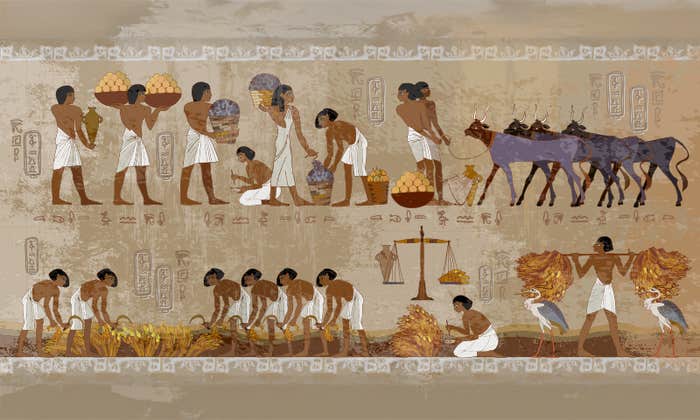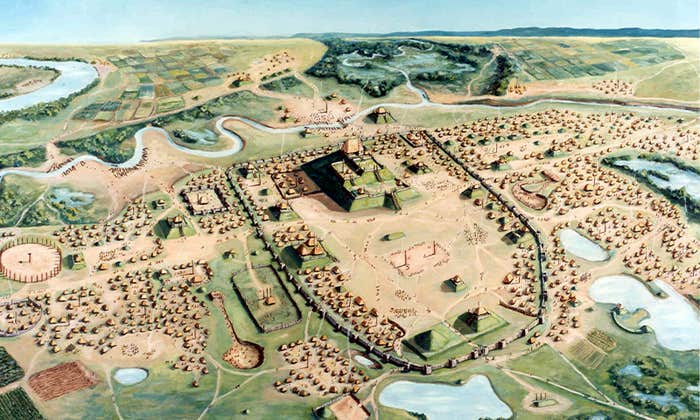It had always been Katherine Goble’s great talent to be in the right place at the right time. In August 1952, 12 years after leaving graduate school to have her first child, that right place was in Marion, Virginia, at the wedding of her husband, Jimmy Goble’s, little sister Patricia. Pat, a vivacious college beauty queen just two months graduated from Virginia State College, was marrying her college sweetheart, a young army corporal named Walter Kane.
Jimmy’s other sister and brother-in-law, Margaret and Eric Epps, had journeyed from Newport News, and the newlyweds planned to accompany the Eppses back to the coast, hitching a ride to their honeymoon at Hampton’s segregated Bay Shore Beach resort. “Why don’t y’all come home with us too?” Eric asked Katherine. “I can get Snook a job at the shipyard,” he said, using Jimmy’s family nickname. “In fact, I can get both of you jobs.” There’s a government facility in Hampton that’s hiring black women, Eric told Katherine, and they’re looking for mathematicians. It’s a civilian job, he told her, but attached to Langley Memorial Aeronautical Laboratory—the oldest outpost of the National Advisory Committee for Aeronautics, or NACA.
Katherine listened intently as her brother-in-law described the work, her thumb cradling her chin, her index finger extended along her cheek, the signal that she was listening carefully. She and Jimmy made a living as public school teachers, but their paychecks were modest. The needs of their three growing daughters seemed greater by the day, and the couple could only just cover their basics and squeeze out a little extra for piano lessons or Girl Scouts. Deft with a sewing machine, Katherine bought fabric from the dry goods store and stayed up nights making school outfits for the girls and dresses for herself. During the summer break from school, the Gobles worked as live-in help for a New York family that summered in Virginia’s Blue Ridge Mountains.

Katherine enjoyed teaching. She felt a keen sense of responsibility to “advance the race,” instilling not just book knowledge but discipline and self-respect in her students, who would need both of those qualities in abundance to make their way in a society stacked against them in nearly every way. She and Jimmy hewed to the path that was so well-worn that the feet of Negro college graduates like them were trained to walk it almost automatically. But Eric Epps’ mention of the mathematics job in Hampton kindled the memory of a long dormant ambition, one Katherine was surprised to find still smoldering within her.
It was late that night when Katherine and Jimmy tucked the girls into their beds and collapsed onto their own bed. Only after exhausting all the other stories of the wedding did they broach the topic that occupied both of their minds. Taking the road to Newport News would mean making a decision quickly. With the school year approaching, the Bluefield principal would need time to find replacements to take over their classes. They would need a place to live. Uprooting the girls on short order and enrolling them in new schools would be trying for all of them. Hampton Roads was far from Jimmy’s parents, and even farther away from Katherine’s parents in White Sulphur Springs, who doted on their granddaughters. It would have been easy to continue with the stable small-town life they had created. But the possibility of this new job tugged at the curiosity that was at the core of Katherine Goble’s nature.
“Let’s do it,” she whispered.
Born and raised in White Sulphur Springs, West Virginia, Katherine was the youngest of Joshua and Joylette Coleman’s four children. “You are no better than anyone else, and no one is better than you,” Joshua told his children, a philosophy he embodied to the utmost. Dressed neatly in a coat and tie whenever he was on business in town, Joshua quietly commanded admiration from both blacks and whites in tiny White Sulphur Springs; you never had to tell anybody to respect Josh Coleman.
Though educated only through the sixth grade, Katherine’s father was a mathematical whiz who could tell how many board feet a tree would yield just by looking at it. As soon as their youngest daughter could talk, Joshua and Joylette realized that she’d inherited her father’s winning way with people and his mind for math. Katherine counted whatever crossed her path—dishes, steps, and stars in the nighttime sky. Insatiably curious about the world, the child peppered her grammar school teachers with questions and skipped ahead from second grade to fifth. When teachers turned around from the blackboard to discover an empty desk in Katherine’s place, they knew they’d find their pupil in the classroom next door, helping her older brother with his lesson. The children’s school, the only one in the area for Negroes, terminated with the sixth grade. When Katherine’s older sister, Margaret, graduated from the White Sulphur Springs schoolhouse, Joshua rented a house 125 miles away so that all four children, supervised by their mother, could continue their education at the laboratory school operated by West Virginia State Institute.
Her requests were gentle but persistent.
In 1933, Katherine entered West Virginia State College as a 15-year-old freshman, her strong high school performance rewarded with a full academic scholarship. On staff in the math department was William Waldron Schieffelin Claytor, movie-star handsome with nut-brown skin and intense eyes fringed by long eyelashes. His brusque manner intimidated most of his students, who couldn’t keep up as the professor furiously scribbled mathematical formulas on the chalkboard with one hand and just as quickly erased them with the other. He moved from one topic to the next, making no concession to their bewildered expressions. But Katherine, serious and bespectacled with fine curly hair, made such quick work of the course catalog that Claytor had to create advanced classes just for her.
“You would make a good research mathematician,” Dr. Claytor said to the 17-year-old undergraduate after her sophomore year. “And,” he continued, “I am going to prepare you for this career.”
A brilliant and ambitious graduate of Howard University and University of Pennsylvania, and one of only three black men in the country with a Ph.D. in mathematics, Claytor had waited in vain to be recruited to join the country’s top math departments, but West Virginia State College was his only offer. As if trying to redeem his own professional disappointment through the achievements of one of the few students whose abilities matched his own, Claytor maintained an unshakable belief that Katherine could meet with a successful future in mathematical research, all odds to the contrary. The prospects for a Negro woman in the field could be viewed only as dismal. In the 1930s, just over 100 women in the United States worked as professional mathematicians. Employers openly discriminated against Irish and Jewish women with math degrees; the odds of a black woman encountering work in the field hovered near zero.
“But where will I find a job?” Katherine asked.
“That will be your problem,” said her mentor.
In June 1953, Katherine Goble began her job as a human computer in Langley’s West Area computing pool, which was where mathematically minded “colored girls” were placed. Her boss was Dorothy Vaughan, another brilliant mathematician who had joined West Computing 10 years earlier and had risen to become the department’s head. It was a great and pleasant surprise to find that Katherine’s new boss was not just a fellow West Virginian but also a former neighbor who had spent much time with her family back in White Sulphur Springs. It didn’t take long for Katherine to appreciate Dorothy’s talents both as a mathematician and as a manager. When they needed more computing power, engineers trusted Dorothy to staff the right person for the job, often hoping that she was at the top of her own list.
In the first few days, Katherine caught on to the routine of filling in data sheets according to equations that had been laid out by Dorothy Vaughan or one of the engineers, who made regular appearances in the office throughout the day. Two weeks after Katherine arrived, when a white man in shirtsleeves came into the office and approached Dorothy Vaughan’s station, initiating a quiet conversation, Vaughan nodded her head and scanned the array of desks, scrutinizing their occupants as she listened. After he left, Vaughan called Katherine Goble and another woman, Erma Tynes, to her desk. “The Flight Research Division is requesting two new computers,” Vaughan said. “I’m sending you two. You’re going to 1244.”
For Katherine, being selected to rotate through Building 1244, a gigantic 295-by-300-foot hangar that sheltered the laboratory’s fleet of research aircraft, felt like an unexpected bit of fortune, however temporary the assignment might prove to be. She had been elated simply to sit in the pool and calculate her way through the data sheets assigned by Mrs. Vaughan. But being sent to sit with the brain trust located on the second floor of the building meant getting a close look at one of the most important and powerful groups at the laboratory.
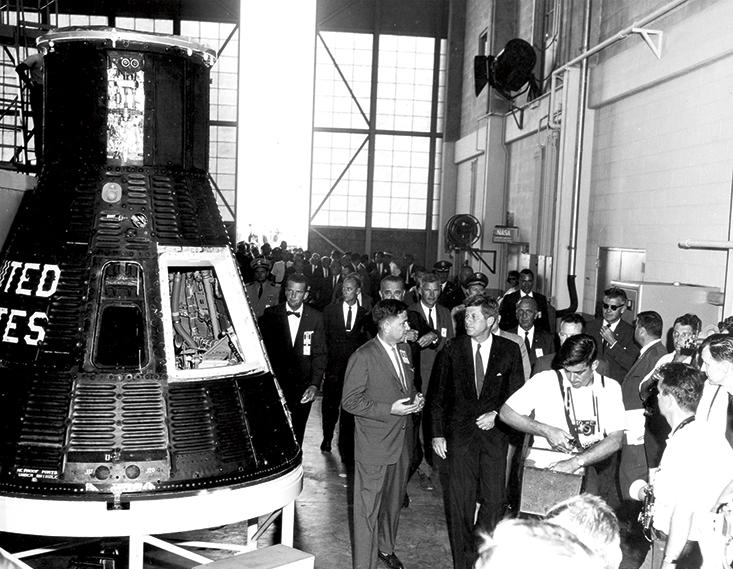
Inside Building 1244, the air reeked of coffee and cigarettes. Most of the people in the space were men, but interspersed among them a few women consulted their adding machines or peered intently at slides in film viewers. Along one wall was the office of the division chief, Henry Pearson, with a station for his secretary just in front. The room hummed with pre-lunch activity as Katherine surveyed it for a place to wait for her new bosses.
Outside the gates, the caste rules were clear. Blacks and whites lived separately, ate separately, studied separately, socialized separately, worshipped separately, and, for the most part, worked separately. At Langley, the boundaries were fuzzier. Blacks were ghettoed into separate bathrooms, but they had also been given an unprecedented entrée into the professional world. Some of Goble’s colleagues were Yankees or foreigners who’d never so much as met a black person before arriving at Langley. Others were folks from the Deep South with calcified attitudes about racial mixing. It was all a part of the racial relations laboratory that was Langley, and it meant that both blacks and whites were treading new ground together. The vicious and easily identifiable demons that had haunted black Americans for three centuries were shape-shifting as segregation began to yield under pressure from social and legal forces. Sometimes the demons still presented themselves in the form of racism and blatant discrimination. Sometimes they took on the softer cast of ignorance or thoughtless prejudice. But these days, there was also a new culprit: the insecurity that plagued black people as they code-shifted through the unfamiliar language and customs of an integrated life.
Katherine understood that the attitudes of the hard-line racists were beyond her control. Against ignorance, she and others like her mounted a day-in, day-out charm offensive: impeccably dressed, well-spoken, patriotic, and upright, they were racial synecdoches, keenly aware that the interactions that individual blacks had with whites could have implications for the entire black community. But the insecurities, those most insidious and stubborn of all the demons, were hers alone. They operated in the shadows of fear and suspicion, and they served at her command. They would entice her to see the engineer as an arrogant chauvinist and racist if she let them. They could taunt her into a self-doubting downward spiral, causing her to withdraw from the opportunity that Dr. Claytor had so meticulously prepared her for.
At six months and counting, Katherine Goble’s temporary assignment in the Flight Research Division was starting to look terribly permanent. So at the beginning of 1954, Dorothy Vaughan made her way to Building 1244 for a sit-down with Henry Pearson, the head of the branch that had “borrowed” her computer and forgotten to return her.
“Either give her a raise or send her back to me,” Dorothy said to Henry Pearson, sitting upstairs in his office in 1244. The meeting ended as they both knew it would, with Pearson offering Katherine Goble a permanent position in his group, the Maneuver Loads Branch, with a corresponding increase in salary. The fact was, the engineers who worked for Henry Pearson realized soon after Katherine Goble took a seat at her desk in 1244 that their new computer was a keeper.
Well into her 90s, Katherine Goble could recall that winking dot of light in the sky as vividly as if it were still October 1957. She stood outside in the unseasonably warm autumn nights of that year and tracked the shiny pinpoint as it moved low across the horizon. Throughout America, citizens turned their eyes skyward with a mixture of terror and wonder, eager to know if the 184-pound metal sphere launched into orbit by the Russians could see them as they tried to see it from their backyards. They surfed the radio dial trying to lock onto the artificial moon’s beeping, its sound like an otherworldly cricket.
While Sputnik circled overhead every 98 minutes, Americans demanded to know how their country, so dominant in its victory in the last war, could have been surprised and usurped by a “backward peasantry” like the U.S.S.R. Fear battled humiliation in the American psyche. “First in space means first, period,” declared Senate Majority Leader Lyndon Johnson. “Second in space is second in everything.”
From where Katherine Goble was sitting, upstairs in Langley’s hangar, the Soviet move looked rather like a new beginning. Skies all over the world bore witness to four decades of successful Langley research, from passenger jets to bombers, transport planes to fighter aircraft. With supersonic military aircraft a reality, and the industry moving forward on commercial supersonic transport, it appeared that the “revolutionary advances for atmospheric aircraft” had run their course. Furthermore, Langley’s high-speed flight operations were officially ended by a 1958 NACA headquarters edict. As Katherine and her colleagues in the Flight Research Division wondered what was next, Sputnik provided them with the answer.
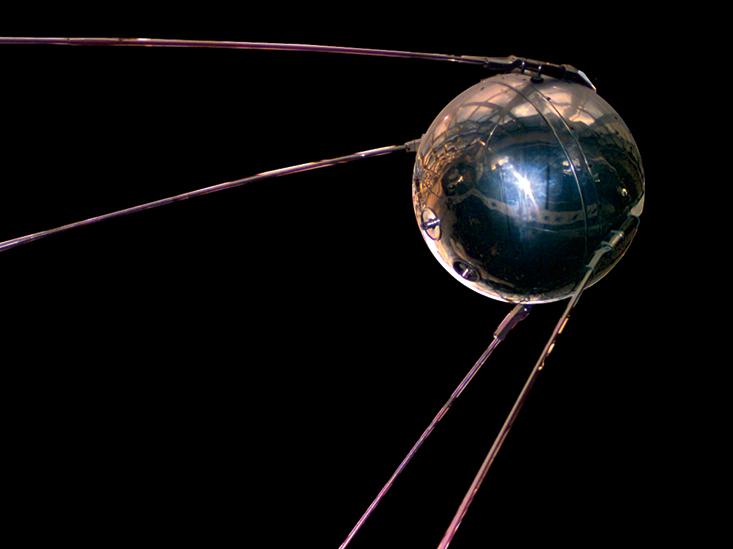
Though many competitors within the U.S. government were vying to lead the space effort— among them the U.S. Airforce and the U.S. Naval Research Authority in Washington, D.C.—it was the NACA that was chosen as the repository for all of America’s disparate space operations. In October 1958, with Langley as the nucleus, the U.S. government fused all the competing operations, along with the Jet Propulsion Laboratory, into the NACA. The expanded mission called for a new name: the National Aeronautics and Space Administration, or NASA.
As Katherine’s division shifted priorities from aeronautics to space, her work took a particularly toothsome turn. Massaging the Monroe calculator (an early adding machine) and filling out the data sheets, which grew longer and wider as the work became more intricate, would still be part of her daily duties. But the engineers in the group now assigned her the job of preparing the charts and equations for the new “self-education” space technology lecture series, in which the engineers of Flight Research and the Pilotless Aircraft Research Division presented their research, from rocket propulsion to orbital mechanics to the problems of re-entry. It was the textbook of outer space, being written in real time.
Katherine listened carefully to everything the engineers said, strained for snippets of conversation, and devoured Aviation Week like a kid reading the funny papers. The real action, she knew, was taking place there in the lectures and editorial meetings, those closed-door sessions where engineers subjected preliminary research reports to the same relentless scrutiny and stress testing that they applied to the aircraft they engineered. Her interest in the proceedings of the meetings increased in direct proportion to her proximity to them. By the measure of the rest of the country, she was an insider’s insider. She enjoyed a front-row seat at a spectacle that the rest of the citizenry learned about in the daily newspaper and on the nightly news. But however close she sat to the room where the meetings took place, she was still an outsider if she couldn’t get in the door.
Katherine sat down with the engineers and, as was her habit, she asked questions. Why did the trajectory equation need to account for the oblateness of Earth? Why was it necessary to calculate an error ellipsoid to accurately predict the satellite’s return to the planet’s surface?
She had asked plenty of questions when the scope of her work had extended only from the nose cone of a tiny Cessna 405 to its tail fin. Now there was so much more to ask, so much more to understand, and because it was all new, she felt like she was right there on the learning curve with the engineers. As the work intensified, something that had been hibernating in her mind awakened, and once roused it would not go away. She considered the issue and checked its logic, just as she did with her analytical work. At first she asked it only of herself, but eventually she came to the engineers with the question.
“Why can’t I go to the editorial meetings?” she asked the engineers. A postgame recap of the analysis wasn’t nearly as thrilling as being there for the main event. How could she not want to be a part of the discussion? They were her numbers, after all.
“Girls don’t go to the meetings,” Katherine’s male colleagues told her.
“Is there a law against it?” Katherine retorted. There wasn’t, in fact. There were laws telling her where she might answer nature’s call—a law she ignored at Langley—and which fountain to drink from. There were laws restricting her ability to apply for a credit card in her own name, because she was a woman. But no law applied to the editorial meeting. It wasn’t personal: It was just the way things had always been done, they told her.
Restricting the computers from joining the editorial meetings wasn’t a rule: It was a rule of thumb. It was rooted in practice and widely implemented, but it did not apply without exception to every situation. Whether or not a woman was promoted, if she was given a raise, if she had access to the smoky sessions where the future was being conceived and built, had much to do with the prejudices and predilections of the men she worked for.
Whatever personal insecurities Katherine might have had about being a woman working with men, or about being one of the few blacks in a white workplace, she managed to cast them aside when she came to work in the morning. The racism stuff, the woman stuff: She managed to tuck all that way in a place far from her core, where it would not damage her steely confidence. As far as Katherine was concerned—as far as she had decided—once they got to the office, “they were all the same.”
“Why can’t I go to the editorial meetings?” Katherine Goble asked again, undeterred by the initial demurral. She always kept up the questioning until she received a satisfactory answer. Her requests were gentle but persistent, like the trickle of water that eventually forces its way through rock. The greatest adventure in the history of humankind was happening two desks away, and it would be a betrayal of her own self-confidence and of the judgment of everyone who had helped her to reach this point to not go the final distance. She asked early, she asked often, and she asked penetrating questions about the work. She asked with the highest respect for the natures of the brainy fellas she worked with, and she asked knowing that she was the right person for a task that needed the finest minds.
As much as anything, she asked with confidence in the ultimate decision.
“Let her go,” they finally said, exasperated. The engineers just got tired of saying no. In 1958, Katherine Goble finally made it into the editorial meetings of the Guidance and Control Branch of Langley’s Flight Research Division, soon to be renamed the Aerospace Mechanics Division of the nearly-ready-for-prime-time National Aeronautics and Space Administration. Now, she was going to come along with the program.
The first attempt to put a man into space, NASA decided, should be a simple ballistic flight, with the capsule fired into space by a rocket like a bullet from a gun or a tennis ball from a tennis ball machine. Capsule goes up, capsule comes down, its path defined by a big parabola, its landing place the Atlantic Ocean. The astronaut needed to return near enough to waiting navy ships to be quickly hoisted out of the water and pulled to safety. The challenge was to rig the machine’s position so that the ball—the Mercury capsule—landed as closely as possible to the navy’s waiting racket. Calculated incorrectly, the ball would go out of bounds, the astronaut’s life endangered.
A well-executed suborbital flight would buy the U.S. a little breathing room; but orbital flight—the endgame of Project Mercury—was infinitely more complex. Successful orbital flight required the engineers to adjust the tennis ball machine’s chute to the correct angle and arm its launcher with enough force to send the ball up through the atmosphere and into an orbit around Earth on a path so precisely specified, so true, that when it came back down through the atmosphere, it was still within spitting distance of the navy’s waiting racket.
“Let me do it,” Katherine said to Ted Skopinski. Working with Skopinski as a computer (or “math aide,” as the women had been renamed when the NACA became NASA), she had proven herself to be as reliable with numbers as a Swiss timepiece and deft with higher-level conceptual work. She was older than many of her colleagues, some of whom were just out of college, but she matched them at every turn for enthusiasm and work stamina. The fellas were putting everything they had on the line, and she was not going to be left out. “Tell me where you want the man to land, and I’ll tell you where to send him up,” she said.
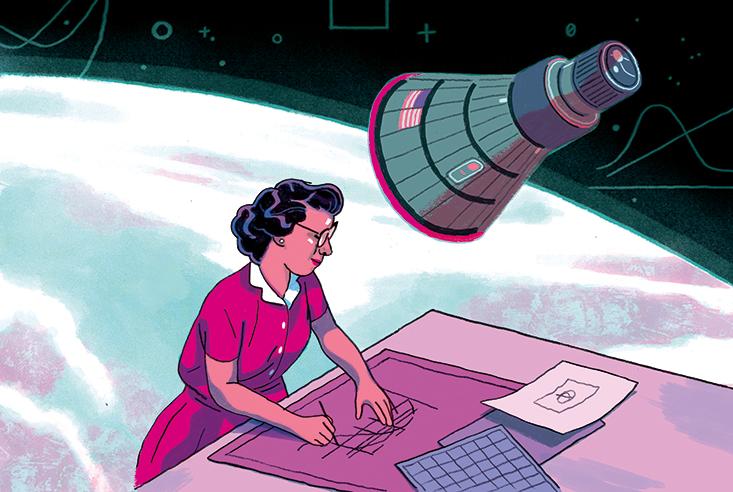
Her grasp of analytical geometry was as good as that of the guys she worked with, perhaps better. And the unyielding demands of Project Mercury and the sprawling, still-forming organization that was being built to manage it stretched everyone to the limit. Soon after John Mayer put on the Space Task Group jersey, Carl Huss and Ted Skopinski followed suit, making Katherine the natural inheritor of the research report that would describe Project Mercury’s orbital flight. As had been the case many other times in her life, Katherine Goble was the right person in the right place at the right moment.
She plunged into the analysis. Earth’s gravity exerted its force on the satellite and had to be accounted for in the trajectory’s system of equations. Earth’s oblateness—the fact that it was not perfectly spherical but slightly squat, like a mandarin orange—needed to be specified, as did the speed of the planet’s rotation. Even if the capsule were to shoot off into the air directly overhead and come back down in the same straight line, it would land in a different spot, because Earth had moved.
“In the recovery of an artificial earth satellite it is necessary to bring the satellite over a preselected point above the earth from which the re-entry is to be initiated,” she wrote. Equation 3 described the satellite’s velocity. Equation 19 fixed the longitude position of the satellite at time T. Equation A3 accounted for errors in longitude. Equation A8 adjusted for Earth’s west-to-east rotation and oblation. She conferred with Ted Skopinski, consulted her textbooks, and did her own plotting. Over the months of 1959, the 34-page end product took shape: 22 principal equations, nine error equations, two launch case studies, three reference texts, two tables with sample calculations, and three pages of charts.
Katherine put the finishing touches on her first research report on the Friday after Thanksgiving in 1959. “Determination of Azimuth Angle at Burnout for Placing a Satellite over a Selected Earth Position” went through 10 months of editorial meetings, analysis, recommendations, and revisions before publication in September 1960—the first report to come out of Langley’s Aerospace Mechanics Division (or its predecessor, the Flight Research Division) by a female author. She signed the report under a new name, taken from the handsome young army captain she married in August 1959: Katherine G. Johnson, the name that history would remember.
She worked through every minute of the mission.
Sending a man into space was a tall order, but it was the part about returning him safely to Earth that kept Katherine Johnson awake at night. Each mission presented myriad pathways to disaster, starting with the notoriously temperamental Atlas rocket, a 95-foot-high, 3.5-million-horsepower intercontinental ballistic missile that had been modified to propel the Mercury capsule into orbit. Two of the Atlas’s last five sallies had ended in failure. One of them had surged into the sky before erupting into spectacular fireballs with the capsule still attached. The capsule itself was the most sophisticated tin can on the planet. The vehicle’s oxygen and pressurization systems stood between the astronaut and the life-crushing vacuum of space. Those functions and more—every switch, every indicator, every gauge—had to be tested and retested for any whiff of possible failure.
The Atlas mission was colossal in its scope, but it required both extreme precision and the utmost accuracy. A number transposed in calculating the launch azimuth, a significant digit too few in measuring the fully loaded weight of the capsule, a mistake in accounting for the rocket’s speed and acceleration or the rotation of the Earth could cascade through the chain of dependencies, causing serious, perhaps catastrophic, consequences. So many ways to screw the pooch, and just one staggeringly complex, scrupulously modeled, endlessly rehearsed, indefatigably tested way to succeed. Nobody, of course, understood this better than astronaut John Glenn. As a seasoned test pilot, Glenn knew that the only way to remove all danger from the mission was to never leave Earth.
From Project Mercury’s outset, the NASA engineers had the delicate task of balancing the drive to get into space as quickly as possible with the risk they felt they could reasonably ask their human cargo to accept. Experience and analysis informed them that somewhere along this venturesome path they were certain to encounter unforeseen problems or run smack into the simple bad luck of statistics, that one time in a thousand when the worst-case scenario played out. What was within their control, however, they took pains to bulletproof, even if it meant stretching—then breaking—their timeline. Project Mercury’s first orbital flight was originally slated to take place at the end of 1960, on President Eisenhower’s watch. Additional testing and fine-tuning—a cooling system bug here, an oxygen delivery glitch there, the need to implement improvements based on previous unmanned and suborbital flights—conspired to push the date into the administration of incoming President Kennedy. NASA set July 1961 as the new date for the orbital flight, then rescheduled it for October, then December. Finally, the Space Task Group affixed Feb. 20, 1962, as John Glenn’s debut.
The incessant delays and high stakes would have caused most individuals to lose their focus, but John Glenn gave even-tempered, optimistic interviews to the impatient press and busied himself by keeping his mind and body in peak condition. Three days prior to the most significant date of his life, Glenn went through a final simulation, carrying out a full checkout of his flight plan. Before commending himself to his destiny, however, the astronaut implored the engineers to execute one more check: a review of the orbital trajectory that had been generated by the IBM 7090 computer.
The message got through to John Mayer or Ted Skopinski, who delivered it to the person it was intended for.
“Get the girl to check the numbers,” said the astronaut. If she says the numbers are good, he told them, I’m ready to go.
The broader implication of her role as a black woman in a still-segregated country, helping to light the fuse that would propel that country to achieve one of its greatest ambitions, was a topic that would occupy Katherine’s mind for the rest of her life. But with the final countdown in sight, that was a matter for the future. Right now, she was a mathematician, an American citizen whose greatest talents had been recognized, and who was about to offer those talents in the service of her country. Katherine Johnson had always been a great believer in progress, and in February 1962, once again, she became its symbol.

When the phone call came in, 43-year-old Katherine was at her desk in Building 1244. She overheard the call with the engineer who picked it up, just as she had overheard the conversation between Dorothy Vaughan and the engineer in 1953, the request that sent her to the Flight Research Division two weeks after she arrived at Langley. She knew she was the “girl” being discussed in the phone conversation. She had seen the astronauts around the building, of course; they had spent many hours in the hangar downstairs, preparing for their missions on a simulation machine called the Procedures Trainer. Some of their briefings with the brainy fellas had happened upstairs, though she was not invited to attend those meetings. That John Glenn didn’t know, or didn’t remember, her name didn’t matter; what did matter, as far as he was concerned—as far as she was concerned—was that she was the right person for the job.
Many years later, Katherine Johnson would say it was just luck that of all the computers being sent to engineering groups, she was the one sent to the Flight Research Division to work with the core of the team staffed on an adventure that hadn’t yet been conceived. But simple luck is the random birthright of the hapless. When seasoned by the subtleties of accident, harmony, favor, wisdom, and inevitability, luck takes on the cast of serendipity. Serendipity happens when a well-trained mind looking for one thing encounters something else: the unexpected. It comes from being in a position to seize opportunity from the happy marriage of time, place, and chance. It was serendipity that called her in the countdown to John Glenn’s flight.
In the final section of the Azimuth Angle research report she completed in 1959, Katherine had marched through the calculations for two different sample orbits, one following an eastward launch and the other a westward, as Glenn was scheduled to fly. Once she had worked out the math for the test scenarios on her calculating machine, substituting the hypothetical numbers for variables in the system of equations, the Mission Planning and Analysis Division within the Space Task Group took her math and programmed it into their IBM 704. Using the same hypothetical numbers, they ran the program on the electronic computer, to the pleasing end that there was “very good agreement” between the IBM’s output and Katherine’s calculations. The work she had done in 1959, double-checking the IBM’s numbers, was a dress rehearsal—a simulation, like the ones John Glenn had been carrying out—for the task that would be laid on her desk on the defining day of her career.
Once the capsule climbed through the launch window, separated from the Atlas, and settled into a successful orbit, it established communication links with the ground stations. As the craft flew overhead, it telemetered a torrent of data to the closest tracking station, everything from its speed and altitude to its fuel level and the astronaut’s heart rate. The tracking stations captured the signals with their 64-foot receiving dishes, then relayed this data plus voice communications through a jumble of submarine cables, landlines, and radio waves to the computer center at Goddard Space Flight Center. The IBM machines used the inputs they received to make calculations based on the orbit determination programs. Via high-speed data lines—a blazing 1 kilobyte per second—Goddard sent Mission Control real-time information on the spaceship’s current position. There, on the front wall of the room that served as NASA’s nerve center, was a huge lighted map of the world. On the map were inscribed sine wave–shaped tracks, one for each orbit. Hovering over the map was a little cutout of a Mercury capsule, suspended on a wire. As tracking data from the spaceship filtered into Mission Control, the toy capsule moved along the orbit grooves on the map too, a puppet controlled by its master in the sky. The capsule’s signal bounced from one tracking station to the next as the orbit proceeded, like a very fast and expensive game of telephone, constantly communicating its position and status. He’s passing over Nigeria! He’s just about to reach Australia! The crude setup seemed like a miracle: Looking at the puppet ship, they could actually “see” the spaceship as it made its rounds.
The Goddard computers also sent the flight controllers their projection of the remainder of the voyage. Where was the capsule compared to where they had calculated it to be at the given time? Was it too high, too low, too fast, too slow? The output included a constantly updated time for retrofire, the moment when the capsule’s rockets had to be fired in order to initiate its descent back to Earth. Retrofiring too soon or too late would bring the unlucky astronaut back down far afield of his navy rescuers.
Katherine organized herself immediately at her desk, growing phone-book-thick stacks of data sheets a number at a time, blocking out everything except the labyrinth of trajectory equations. Instead of sending her numbers to be checked by the computer, Katherine now worked in reverse, running the same simulation inputs that the computer received through her calculator, hoping that there would be “very good agreement” between her answers and the IBM machines, just as had been the case when she originally ran the numbers for the Azimuth Angle report. She worked through every minute of what was programmed to be a three-orbit mission, coming up with numbers for 11 different output variables, each computed to eight significant digits. It took a day and a half of watching the tiny digits pile up: eye-numbing, disorienting work. At the end of the task, every number in the stack of papers she produced matched the computer’s output; the computer’s wit matched hers.
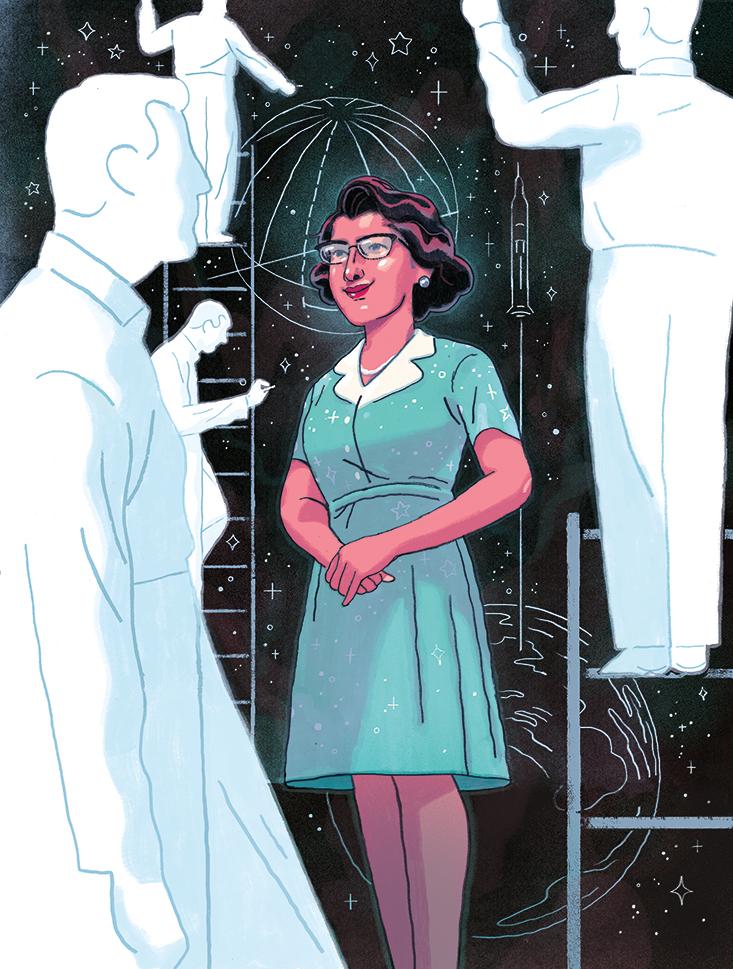
February 20th dawned with clearing skies. One-hundred-thirty-five million people, an audience of unprecedented size, tuned in to watch the spectacle as it unfolded on live television. Many Langley folks joined the Space Task Group down at Cape Canaveral to see the flight in person. Katherine sat tight in the office, watching the transmission on television.
At 9:47 a.m., the Atlas rocket boosted Friendship 7 into orbit like a champion archer hitting a bull’s-eye. The insertion was so good that the ground controllers cleared Glenn for seven orbits. During the first orbit, the capsule’s automatic control system began to act up, causing the capsule to pull back and forth like a badly aligned car. The problem was relatively minor; Glenn smoothed it out by switching the system to manual, keeping the capsule in its correct position the same way he would have flown a plane. At the end of the second orbit, an indicator in the capsule suggested that the all-important heat shield was loose. Without that firewall, there was nothing standing between the astronaut and the 3,000-degree Fahrenheit temperatures—almost as hot as the surface of the sun—that would build up around the capsule as it passed back through the atmosphere. From Mission Control came an executive decision: at the end of the third orbit, after the retrorockets were to be fired, Glenn was to keep the rocket pack attached to the craft rather than jettisoning it as was standard procedure. The retropack, it was hoped, would keep the potentially loose heat shield in place.
Four hours and 33 minutes into the flight, the retrorockets fired. John Glenn adjusted the capsule to the correct re-entry position and prepared himself for the worst. As the spaceship decelerated and pulled out of its orbit, heading down, down, down, it passed through several minutes of communications blackout. There was nothing the Mission Control engineers could do, other than offer silent prayers, until the capsule came back into contact. Fourteen minutes after retrofire, Glenn’s voice suddenly reappeared, sounding shockingly calm for a man who just minutes before was preparing himself to die in a flying funeral pyre. Victory was nearly in hand! He continued his descent, with the computer predicting a perfect landing. When he finally splashed down, he was off by 40 miles, only because of an incorrect estimate in the capsule’s re-entry weight. Otherwise, both computers, electronic and human, had performed like a dream. Twenty-one minutes after landing, the USS Noa scooped the astronaut out of the water.
John Glenn was a bona fide hero, but he wasn’t the only one being cheered. Word of Katherine Johnson’s role in Glenn’s successful mission began making the rounds in the black community, first locally, then farther afield. On March 10, 1962, a glamorous Katherine Johnson, bedecked in pearls and an elegant suit, smiled from the front page of the Pittsburgh Courier. “Her name … in case you haven’t already guessed it … is Katherine Johnson: mother, wife, career woman!” (Below the feature on Katherine Johnson, another headline inquired: “Why No Negro Astronauts?”) The newspaper recounted the lady mathematician’s background and accomplishments with pride, detailing the report that sent Glenn’s rocket cone whizzing through the sky. Katherine accepted the recognition graciously: all in a day’s work.
Margot Lee Shetterly is a nonfiction writer. Her first book, Hidden Figures, is being made into a film, also called Hidden Figures, starring Taraji P. Henson as Katherine Johnson. The movie will be in theaters on Jan. 6, 2017.
From the book Hidden Figures by Margot Lee Shetterly. Copyright © 2016 by Margot Lee Shetterly. Reprinted by permission of William Morrow, an imprint of HarperCollins Publishers.


















